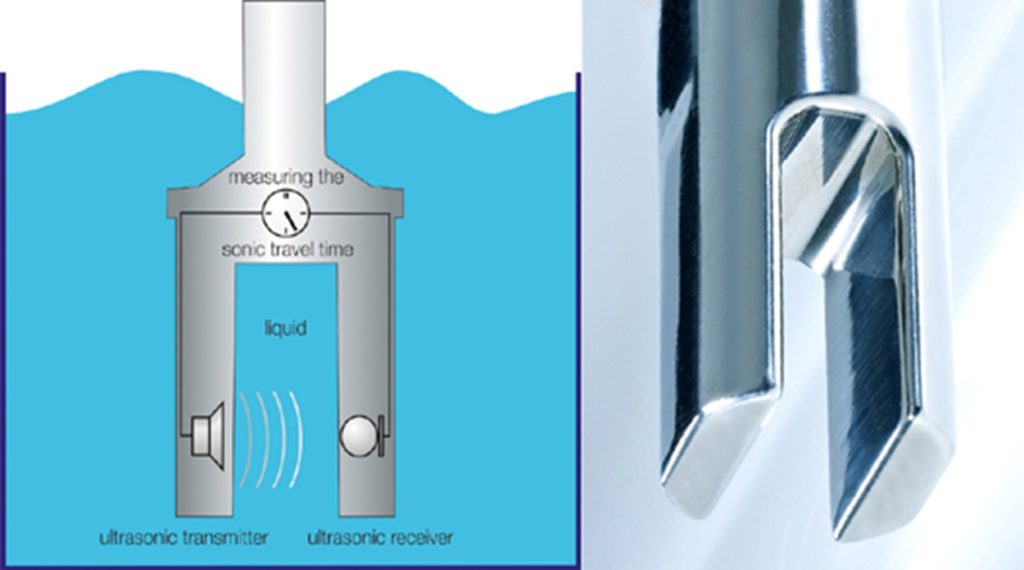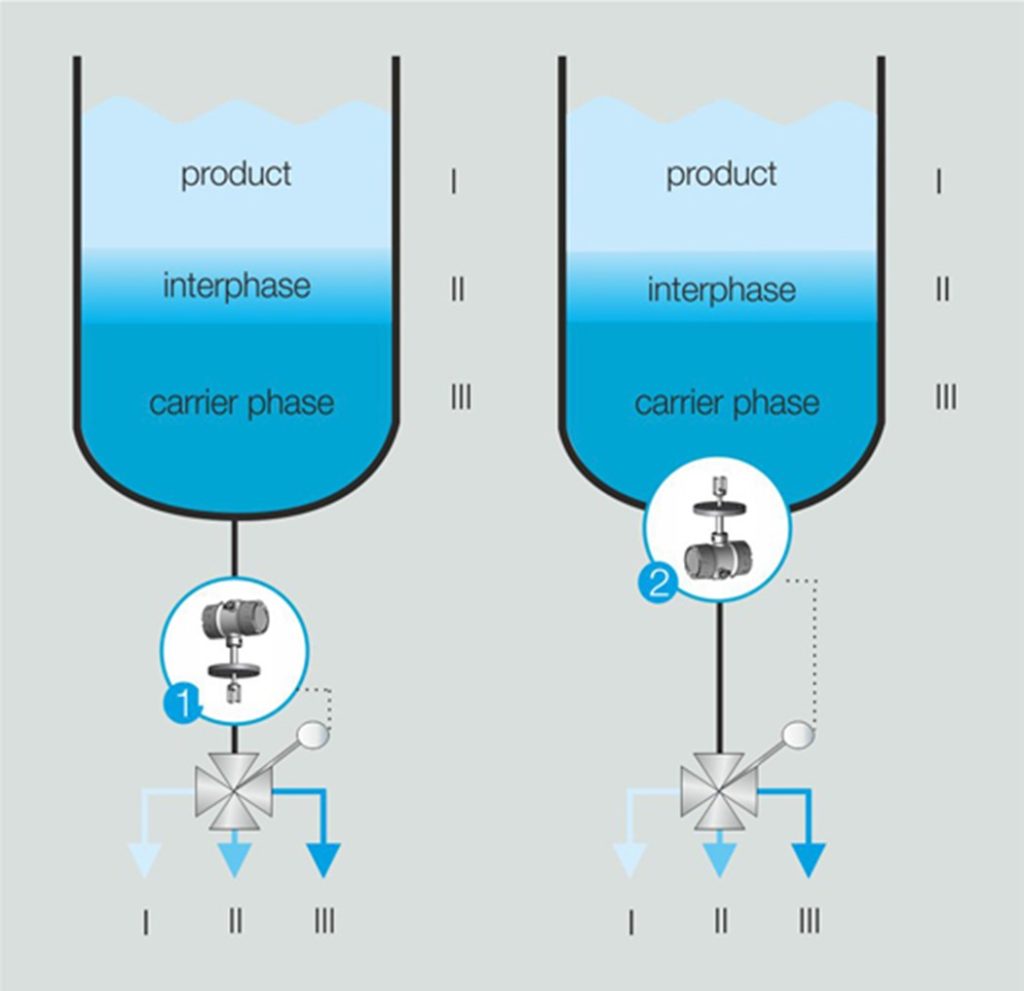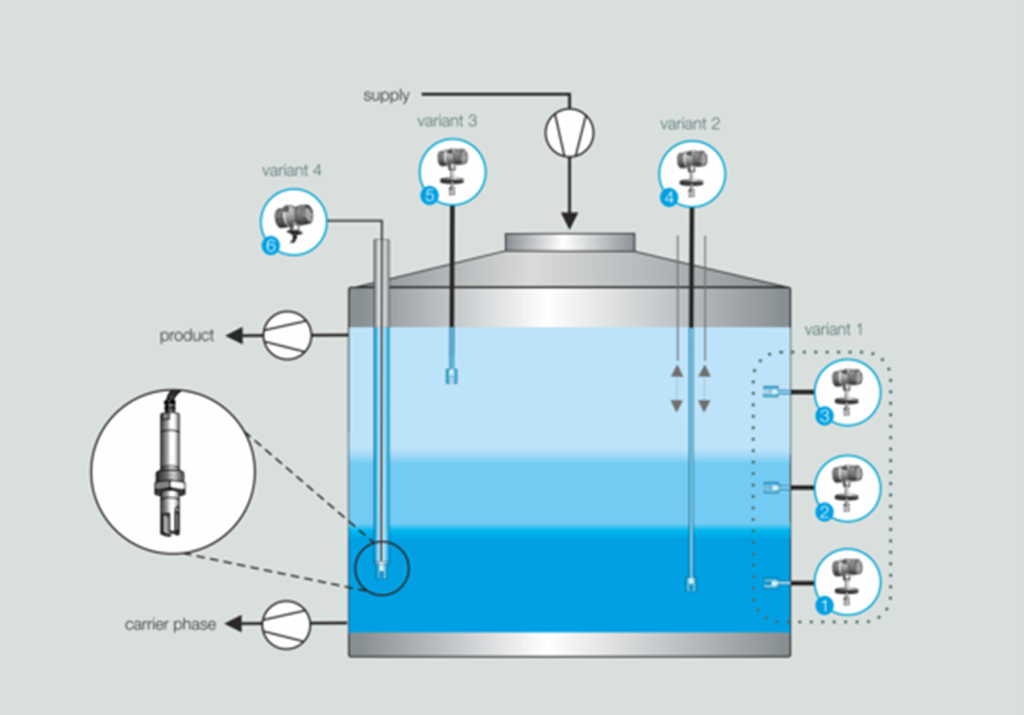Sonic velocity for concentration and density measurement in liquids
How sonic velocity measurements work
The sonic velocity can easily be calculated by measuring the travel time of the sonic signal. With the sonic velocity the device calculates the concentration or density of the liquid. More concentration units can be displayed, e.g. Brix, solid content, dry matter or suspension density.
The measuring principle only requires a time measurement that can be realized digitally with outstanding accuracy and long time stability. Sonic velocity analyzers have no moving parts; therefore there is no long time degradation of their mechanical properties. Using this sensor technology, the user will have several advantages against competitive methods.
The sensor firmware calculates the sonic velocity by using the known distance between the transmitter and receiver. The typical sensor design includes transmitter and receiver within one rough construction.

The measuring method is independent of conductivity, color and transparency of the liquid and has excellent reliability. The user achieves an accuracy between 0.05 % and 0.1 % by weight. In addition to the sonic velocity measurement, all LiquiSonic® sensors have an integrated temperature measurement.
The ultrasonic analyzer LiquiSonic® measures the concentration and density of liquids.
In a typical application, the device measures the sonic velocity and compares it to a calibration curve to generate a concentration value.

concentration monitoring and blending

limit value monitoring
Density and sonic velocity of several liquids can be measured with this method including H2SO4 , Ammonia, Chloride and many more.
Phase interface detection
Many industrial processes involve two separate phases. The fast reaction time of the sensor and electronics provide a quick response for detecting the phase change. This is possible in continuous as well as in batch processes.
The increasing degree of automation requires reliable sensor solutions for certain detection of these phase interfaces in the running process. The application of sonic velocity technology yields the following advantages:
- displacement of manual detection principals (e.g. visual), thereby elimination of human factors to achieve a higher level of safety
- redemption of inaccurate non-direct methods (e.g. time operation) to achieve a higher level of productivity
- improvement of product yield by waste reduction
- safety aspects
Batch process
In a batch process, the response signal of sonic velocity can be used for the direct control of a multi-way valve. This allows a separation between the product, intermediate and carrier phase.
The sensor response time is 250 milliseconds.
Usually, the sensor will be installed into the pipeline. Alternatively, the sensor is integrated in the bottom outlet valve of the company SchuF. Mounting the valve into the vessel enables a measurement directly in the vessel without dead space and without an extra process connection.

Continuous process
Installing the sensors at different heights of a settling tank controls the separation of the process stream into the product phase and carrier phase. In this application, the sonic velocity value of each phase will be kept constant, while switching the valves of every outlet.
A typical application is the separation of process waste water into a stream, into the effluent treatment and into the recovery stream.
There are different variants of installing the sensors into the vessel.

Neutralization
The online measuring technology is able to adjust exactly the feed or surplus of alkalis, which result in cost savings and plant safety.
Neutralizations are of great importance in chemical processes for
- protection of plants (pipes, tanks and vessels) against corrosion,
- optimal conditions for chemical processes,
- neutralization of solution as a preliminary stage of waste water treatment.
In many cases, the customer has to deal with process conditions like high temperatures or aggressive process liquids, for which LiquiSonic® sensors can be used without problems. Due to their rugged construction and special materials, they are able to measure with high precision even in difficult conditions.
The neutralization of gaseous components caused by process exhaust air is also of great importance. Here gas scrubbers are used, which absorb the components of the gas flow by means of a scrubbing liquid.

Polymerization monitoring
High performance polymers are manufactured by numerous industries, and have to meet the highest requirements. The production of such products are run under high temperature and pressure conditions. Because of related process conditions the control of such processes have to follow very high safety demands.
But the safety issue is only one critical point. It is necessary to define process control and monitoring to achieve the expected properties and quality of the final product. For such applications, sonic velocity sensors are the first choice:
Determination of monomer concentration
- concentration of monomer in the solvent
- control of monomer or starter dosage
Polymerization monitoring
- real time monitoring of polymerization reaction
- detection of process disturbances for example delayed reaction start or interruption in the monomer dosage
- continuous monitoring of the reaction turn over
- precise end point determination
Concentration of polymers
- determine the concentration of monomer traces in the polymer
- direct polymer concentration measurement (concentration of lattices)
